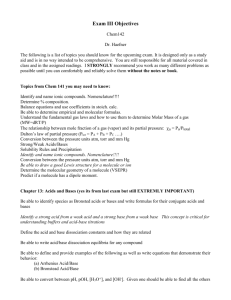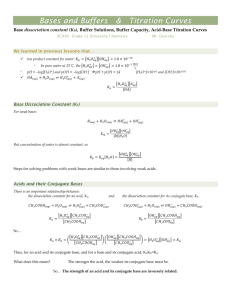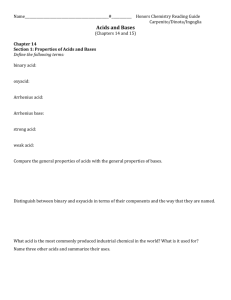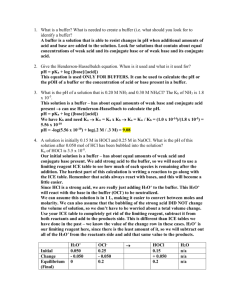16.1 Introduction to Acids and Bases Brønsted–Lowry acids and
advertisement
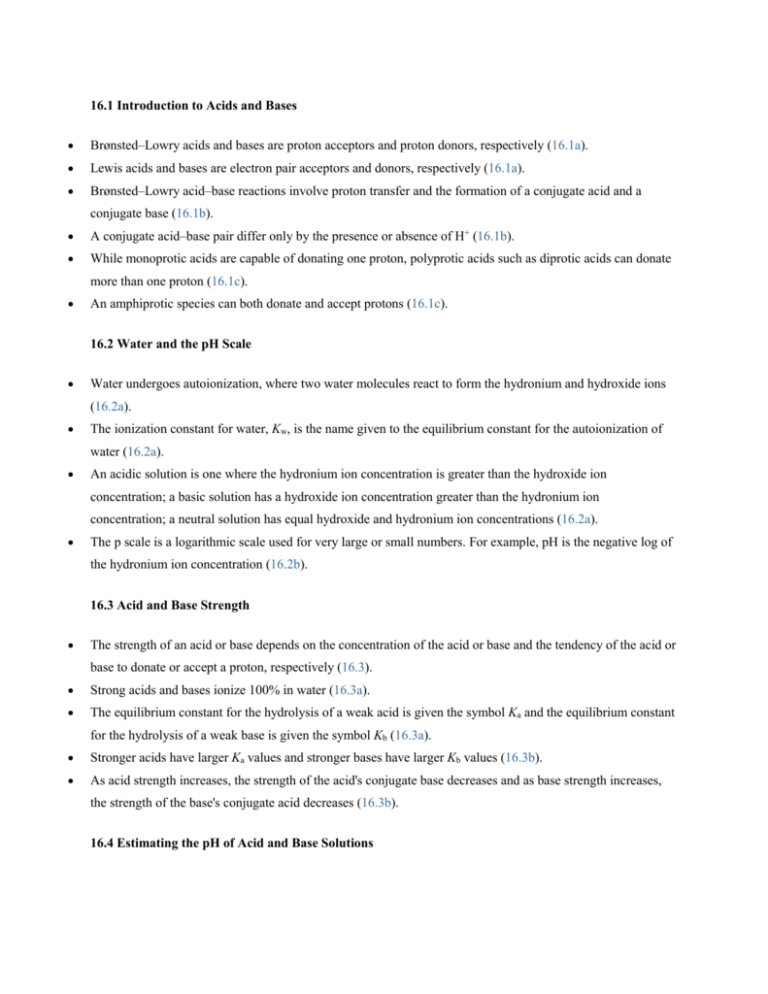
16.1 Introduction to Acids and Bases Brønsted–Lowry acids and bases are proton acceptors and proton donors, respectively (16.1a). Lewis acids and bases are electron pair acceptors and donors, respectively (16.1a). Brønsted–Lowry acid–base reactions involve proton transfer and the formation of a conjugate acid and a conjugate base (16.1b). A conjugate acid–base pair differ only by the presence or absence of H+ (16.1b). While monoprotic acids are capable of donating one proton, polyprotic acids such as diprotic acids can donate more than one proton (16.1c). An amphiprotic species can both donate and accept protons (16.1c). 16.2 Water and the pH Scale Water undergoes autoionization, where two water molecules react to form the hydronium and hydroxide ions (16.2a). The ionization constant for water, Kw, is the name given to the equilibrium constant for the autoionization of water (16.2a). An acidic solution is one where the hydronium ion concentration is greater than the hydroxide ion concentration; a basic solution has a hydroxide ion concentration greater than the hydronium ion concentration; a neutral solution has equal hydroxide and hydronium ion concentrations (16.2a). The p scale is a logarithmic scale used for very large or small numbers. For example, pH is the negative log of the hydronium ion concentration (16.2b). 16.3 Acid and Base Strength The strength of an acid or base depends on the concentration of the acid or base and the tendency of the acid or base to donate or accept a proton, respectively (16.3). Strong acids and bases ionize 100% in water (16.3a). The equilibrium constant for the hydrolysis of a weak acid is given the symbol Ka and the equilibrium constant for the hydrolysis of a weak base is given the symbol Kb (16.3a). Stronger acids have larger Ka values and stronger bases have larger Kb values (16.3b). As acid strength increases, the strength of the acid's conjugate base decreases and as base strength increases, the strength of the base's conjugate acid decreases (16.3b). 16.4 Estimating the pH of Acid and Base Solutions The pH of a solution containing a strong acid or strong base is calculated directly from the strong acid or strong base concentration (16.4a). The pH of a solution containing a weak acid or weak base is calculated from the weak acid or weak base concentration and the equilibrium constant for the hydrolysis reaction of the weak acid or weak base (16.4b, 16.4c). 16.5 Acid–Base Properties of Salts The acid–base properties of a salt are determined by the hydrolysis reactions of the cation and anion that make up the salt (16.5a). 16.6 Molecular Structure and Control of Acid–Base Strength Relative acid–base strength can be predicted or explained by the strength of the chemical bonds in the acid or base and the number of highly electronegative atoms in the acid or base (16.6a). 17.1 Acid–Base Reactions The reaction between a strong acid and a strong base has a large equilibrium constant and produces water and a pH-neutral salt (17.1a). The reaction between a strong acid and a weak base has a large equilibrium constant and produces water and an acidic solution because of the presence of the conjugate acid of the weak base (17.1b). The reaction between a strong base and a weak acid has a large equilibrium constant and produces water and a basic solution because of the presence of the conjugate base of the weak acid (17.1b). In general, all acid–base reactions favor the direction where a stronger acid and base react to form a weaker acid and base (17.1b). The reaction between a weak acid and a weak base has a small equilibrium constant and produces water and a solution whose pH is dependent on the nature of the predominant species in solution (17.1b). 17.2 Buffers A buffer solution contains a mixture of a weak acid and a weak base, typically the conjugate base of the weak acid (17.2a). The Henderson–Hasselbalch equation is one method used to calculate the pH of a buffer solution (17.2b). In a buffer solution, when [weak acid] = [conjugate base], the pH is equal to the weak acid pKa(17.2b). The most effective buffers contain significant amounts of weak acid and conjugate base and have a pH equal to the weak acid pKa ± 1 (17.2b). Buffer capacity is the amount of strong acid or base that can be added to a buffer without a drastic change in pH (17.2b). Two methods for preparing a buffer are the direct addition method and the acid–base reaction method (17.2c). The composition of a buffer solution as a function of pH is shown graphically in an alpha (α) plot (17.2c). 17.3 Acid–Base Titrations The pH at the equivalence point of a strong acid/strong base titration is equal to 7 (17.3a). The pH at the equivalence point of a weak acid/strong base titration is greater than 7 because of the presence of the conjugate base of the weak acid (17.3b). After the addition of titrant but before the equivalence point in a weak acid/strong base or weak base/strong acid titration, the solution contains a buffer (17.3b). The half-equivalence point in a titration is when half of the species being titrated has been consumed (17.3b). In a weak acid/strong base titration, pH = pKa at the half-equivalence point (17.3b). The pH at the equivalence point of a weak base/strong acid titration is less than 7 because of the presence of the conjugate acid of the weak base (17.3b). In a weak base/strong acid titration, pOH = pKb at the half-equivalence point (17.3b). Titration plots can be used to determine the species being titrated, the relative strength of the acid (or base) being titrated, and the Ka value for the weak acid (or Kb value for the weak base) being titrated (17.3c). The pKa of an acid–base indicator should be as close as possible to the pH at the equivalence point of the titration (17.3d). Polyprotic acid titration plots show more than one equivalence point if there is a large difference between the pKa values for the acid (ΔpKa > 3) (17.3e). 17.4 Some Important Acid–Base Systems The carbonic acid/bicarbonate ion/carbonate ion system is the principal buffer system in our blood (17.4a). Amino acids, compounds containing both a carboxylic acid group (—CO2H) and an amine group (—NH2), exist as zwitterions, compounds containing both a positive and negative charge, when dissolved in water, in bodily fluids, and in the solid state (17.4b). The pH at which an amino acid has equal numbers of positive and negative charges is called the isoelectric point (17.4b). 18.1 Solubility Equilibria and Ksp The solubility product constant, Ksp, is the equilibrium constant for the dissolution of a sparingly soluble compound (18.1b). Ksp values are determined from experimental equilibrium ion concentrations or calculated from solubility values (18.1c). 18.2 Using Ksp in Calculations The solubility of a salt in pure water is defined as the amount of solid that will dissolve per liter of solution (g/L or mol/L) and can be calculated from Ksp values (18.2a). Solubility and Ksp are related by compound stoichiometry (18.2a). The reaction quotient, Q, can be used to determine whether a solution is at equilibrium (saturated solution), whether additional solid can dissolve (unsaturated solution), or whether a precipitate will form (supersaturated solution) (18.2b). The presence of a common ion always decreases the solubility of an ionic compound (18.2c). 18.3 Lewis Acid–Base Complexes and Complex Ion Equilibria A Lewis base, an electron-pair donor, donates a lone pair of electrons to a Lewis acid, an electron-pair acceptor, to form a Lewis acid–base adduct (or Lewis acid–base complex) (18.3a). The bond between a Lewis acid and a Lewis base is called a coordinate–covalent bond (18.3a).

